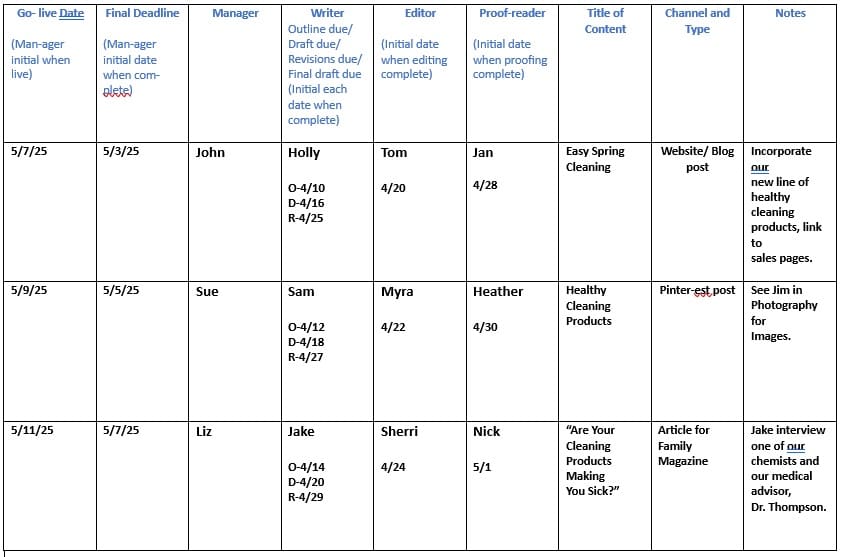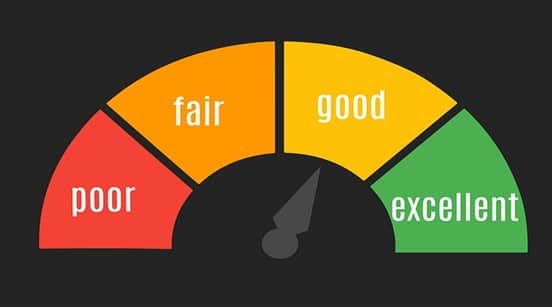Scheduling Your Content Campaign
February 20, 2024
Call it a content schedule, a content calendar, a content marketing plan, an editorial calendar, or anything you like. Whatever you call the document that puts—and keeps—your content campaign on schedule, it’s a necessity given the current nature of marketing.
That’s because marketing has done a hairpin turn away from old-fashioned scattershot advertising campaigns and toward targeted content-centered marketing. This type of directed marketing takes calculation and planning.
For most companies, building a calendar for a content campaign will mean getting multiple parties to agree on the plans it lays out and their feasibility. From the C-suite, through creatives, merchandising people, and finance, it must work for everyone. And it must be easy for everyone to access.
Prerequisite #1: Develop a content strategy.
What do you want your content campaign to accomplish? Who are the customers or clients you must reach and convert for this content campaign to succeed? Which channels and types of content will best do the job of gaining the attention and interest of those customers?
Collective brainstorming that brings in the perspectives of all involved staff members can help answer these questions. Other methods include audience focus groups, customer surveys, your own online research, and market research data compiled by “business intelligence” firms.
These techniques and sources can help you thoughtfully choose the channels where your content will most likely hit its target audiences.
The “flip side” of this choosing process is also important and involves using some measuring tools to gauge how well those channels work for your campaign.
KPI’s, or key performance indicators, are very useful tools for doing that. They provide the numbers savvy content marketers use to keep a close eye on how their channels perform. These indicators are accessed through available software that can collect information such as:
- Search engine performance, or ranking
- Rate of click-through
- Traffic on your website
- Number of unique visitors
- Time spent with your content
- Return on investment (ROI)
- Conversions (sales)
- And more
KPI software compiles the information you want and presents it as reports. These can be shared with your stakeholders to direct either staying on course or making strategic changes.

Prerequisite #2: Get buy-in for your content marketing plans.
Again, all parties should be involved in this stage. Be sure not to leave out anyone who will be responsible for the creation, editing, revising, proofing, or dissemination of content. You don’t want to spring the news of a fully formed campaign, as an unwelcome surprise, on those who will be producing it!
Achieving buy-in from these professionals will involve having—at least—these three discussions:
1) The rationale for having a schedule in place. Upsides to point out include: Everyone will know what is required of them and can better manage their time; staff can better coordinate their efforts; content is improved by advance planning; everyone can see the “big picture” of your marketing strategy; and any other reason that applies to your company’s methods and culture.
2) The methods that will be used to share and access the campaign calendar. This decision, too, is connected to company culture. For instance, if you have an existing, well-used intranet, locating your calendar there can make a lot of sense. If you have employees who like hard copies, you can provide those as an option. Be creative. If you need to post a large laminated monthly content calendar on the wall as a visual reminder, do that.
3) The types and frequency of content, the channels where each kind will be published, and the people responsible for each content category. The more your content production staff knows in advance about exactly what they’ll be producing and how often, the better.
As you have the third discussion, consider these content types and which of your people can best team up to produce each type:
- Dynamic, interactive website copy. Include a homepage, “about” page, product pages, blogs, tutorials, white papers, case studies—whatever serves your business best.
- Regular emails. Keep your customers in-the-know about your new or seasonally offered products, services, locations, sales events, your people, and more. Note: Always send a test email before sending your latest one to customers!
- Ad copy, both digital and print, and advertorials. These can tell well-timed, newsy, relatable stories about your offerings and what makes them great.
- Social media. Platform choices are now almost limitless. Of course, your choices will be based on your target audiences. For example, LinkedIn and TikTok usually serve quite different audiences—professionals and youthful users, respectively. Social media platforms are spontaneous by nature, making them good places to promote seasonal or special events that grab customer attention quickly.
- Digital or print brochures. This time-honored tool still works for at-a-glance advertising and can now live on your website or be attached to an email or blog for easy download.
- Landing pages. When your customers or clients are searching for what you offer, these stand-alone webpages are exactly where you want them to land. Once there, they’ll find engaging copy, graphics and more that show they’re in the right place.
- Sales and data sheets. These give potential customers all the particulars about your products and services.
- Press releases. These quickly get important company news out or show how your company is responding to a news event related to your industry.
- E-books. These downloadable books do digital wonders to exhibit your company’s thought leadership.
There are many ways to facilitate discussions and achieve buy-in. If time permits, a “content scheduling workshop” may be a good idea. When planning a workshop or meeting, allow time to field questions, make clarifications, and entertain input and practical suggestions.
Make or choose a content planning template.
There are at least a few good reasons for using a template to develop a content schedule:
- A template standardizes and simplifies the planning process.
- A template sets expectations for the completion of the phases of production for each piece: outlining, creation, editing, revising, proofing, and dissemination.
- A template puts accountability for deadlines in a visible form for each team member.
There is no one “right” template for content planning. Your company’s template should be customized to work best for your team and environment. It’s great for everyone to have an overview of your entire campaign, but if you are planning lots of content for each channel, assignees will probably thank you for producing a separate sub-calendar for each channel.
Here’s one possible template structure for master planning:

Online tools such as this one are also available to make scheduling your strategic marketing content easier, and to help automate your marketing efforts.
Build your editorial calendar.
As Jay Leonard of Business2community.com notes, “If you schedule campaigns or posts in no specific pattern, you might find that your reader activity isn’t as great as it can be.”
Of course, the whole idea is to get lots of reader activity, which means getting the eyes of your customers on your content. So, when building an editorial calendar, what kinds of factors should you consider? Here are some of the “biggies:”
- The scope of the campaign, in terms of both content and time.
- The frequency of publication for each type of content. A blog, for example, may be posted weekly; a newsletter produced monthly; a landing page updated annually.
- The budget allocated for creating, refining, and publishing each type of content. Writing an e-book will take more of your staff’s time than a blog post. Editing, proofing, and uploading voluminous web content will take much more of their time than writing a press release.
- Seasonality and other factors that make specific times optimal for publication of certain content: holidays large and small, company anniversaries, planned sales events, and community outreach events, for example.
- The workload for creatives, graphics people, and other marketing staff. Pacing will be required.
- Timing of interviews with in-house or external subject matter experts. Internal experts must be available to meet with writers.
With all these factors in mind, you can build your schedule, incorporating the time to be spent on each task (outlining, creation, editing, revising, proofing, dissemination) and deadlines for completion.
Find specific topics.
The Content Marketing Institute (CMI) suggests finding angles for content topics by using a keyword research tool such as Serpstat to find the intersection of your holiday, event, or occasion and the name of the product or service you want to promote. At this intersection, you will find the best ideas and inspiration.
CMI also suggests using TextOptimizer to “better understand and optimize your content to match Google and your site users’ expectations.” This type of tool can help your writers find the best search terms to include in each piece.
Get advance sign-off on your calendar from all parties.
Let everyone involved in any phase of producing, refining, approving, and posting your content have a look at your calendar before it goes live. Depending on an individual’s role, they may need to see all or part of the calendar.
This last viewing gives everyone a “heads up” on their upcoming content-related workload. It also provides a “window” to adjust the schedule if necessary before it goes into effect. Adjustments might be needed to better coordinate steps or better align content to a buying calendar, cashflow, or other factors.
Manage your scheduled content.
Managing your content can mean sending, or automating the sending of, advance notices about upcoming content deadlines. It can also mean regular “status” meetings.
Both tactics will help your team avoid “oopsies” by giving members opportunities to anticipate problems and decide how to deal with them in advance.
Also, if your KPIs and customer feedback indicate that changes should be made to content plans because of changing market conditions and trends, advance notices and meetings give time for discussion about exactly what those changes should be.

Evaluate your calendar regularly …
An annual survey of everyone who uses the editorial calendar will help you stay on top of what is working with the format and use of the calendar, and what could use some tweaking.
It’s possible that methods of access might need to be changed, or that another format would be more practical for users. It’s also possible that upgrading the content strategy template by adding or improving imbedded communications tools would make it more usable.
… or get a content marketing strategist to help with all of the above.
Getting the help of an expert content marketing firm can make a lot of sense. With a deep understanding of marketing concepts and well-honed content writing skills, a company like The Writers for Hire can step in to assist your marketing department or completely handle each step of the process:
- Developing audience personas
- Answering the question, “Which problems do my customers need to solve?”
- Clarifying your brand’s qualities
- Selecting the channels your customers or clients most use
- Choosing KPIs to measure channel performance
- Producing a complete content calendar or multiple calendars
And, if you wish:
- Writing original, timely content for all your channels
When you hire a seasoned team to help develop your content marketing plans, the process becomes a collaborative and painless one. And your staff can continue doing what they already do best.































